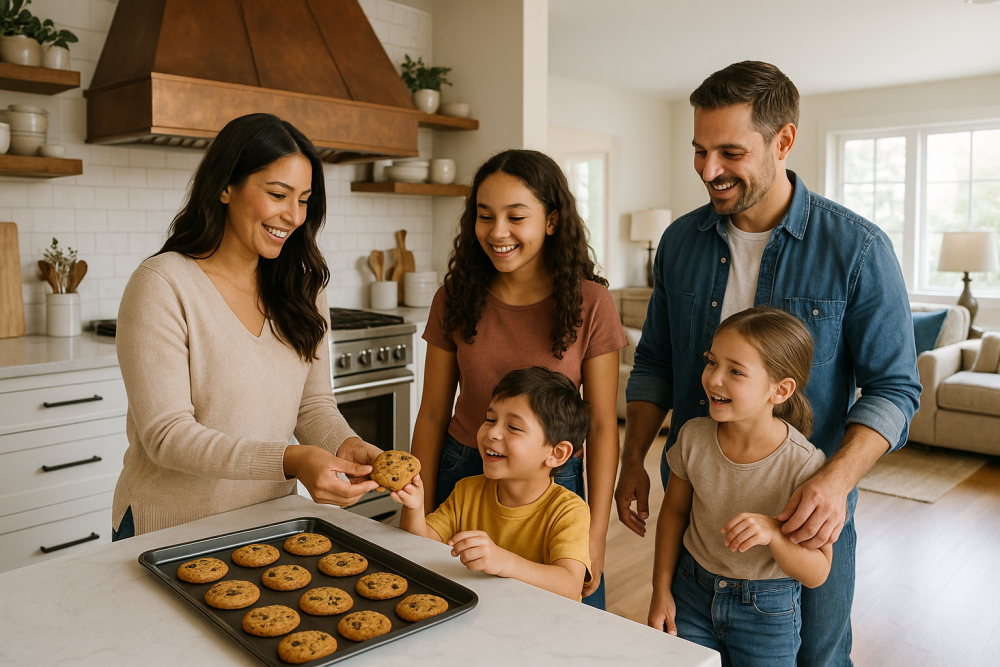From full days spent in bed and aesthetic kitchens to a surge in home therapy rituals, Americans are rethinking what it means to unwind. These trends reveal a growing desire for personal spaces that do more than look good — they need to feel good, too.
To better understand what that means in practice, we surveyed 1,000 Americans about how they relax at home — and what’s getting in their way. The findings point to a culture stretched thin, craving restoration, and eager for home environments that help them slow down, connect, and breathe.
Key Takeaways
-
Only 26% of Americans say they can relax at home daily, and 1 in 3 need at least 30 minutes to fully unwind.
-
Nearly 40% of people bond in the kitchen, and 1 in 4 consider it one of their home's most relaxing and memorable spaces.
-
1 in 4 people say outdoor spaces are among their most relaxing, and 31% want a more peaceful outdoor space.
-
Just 8% said the bathroom is where they feel most relaxed, and nearly 1 in 3 desire a better bath or shower experience.
-
Ohio, Pennsylvania, and Nebraska show the highest interest in at-home relaxation, with 1 in 3 Americans identifying as Slowdwellers — the top relaxation persona ahead of Hushitect (20%) and Soulsoaker (15%).
-
75% face at least one major obstacle to relaxing at home — Nearly 50% say they lack time to relax due to work and other obligations, and 30% feel their home life is too noisy or stimulating.
How Long Does It Take to Relax? Why Does It Matter?

Most Americans do not relax the moment they get home — they need time, space, and the right emotional temperature: calm surroundings, reduced pressure, and the ability to shift gears mentally. In a society where productivity is prized and rest feels indulgent, many people carry the day's stress right through their front door.
More than 42% of people said it takes more than 30 minutes to feel truly calm. Just 14% said they can relax immediately, while 15% said it takes over an hour. Gen Z respondents were the least likely to relax instantly, with only 9% saying they could unwind immediately.
Women were more likely to need time to unwind: 45% said they need 30 minutes or more, compared with 39% of men. These differences may reflect broader cultural dynamics, including how gender roles and mental load shape the ability to relax at home.
In a world full of constant notifications and blurred lines between work and home, the need for mental transition time has become harder to meet and more essential than ever. Many people don’t jump into relaxation rituals the moment they walk in the door. Sometimes, they don’t have the energy to do anything at all.
The most common ways people unwind at home weren’t active or intentional—they were habits of surrender:
-
51% lie in bed or on the couch doing nothing, known as “bed-rotting”.
-
48% turn on the TV or engage in streaming.
-
29% scroll their phones (classic “doomscrolling”).
-
19% opt for a bath or shower.
These patterns reveal something important: relaxation isn’t always a conscious act—it’s often about finding relief with minimal effort. When the environment supports it, even passive behaviors like resting, watching TV, or taking a bath can become genuinely restorative.
The Mental and Physical Obstacles to Calm
Even when Americans want to relax, they are blocked by guilt, distraction, noise, and spatial constraints. The home — ideally a place of refuge — often competes with tasks, noise, and digital clutter.
The most commonly reported barriers to relaxing at home include feeling too busy with work or other obligations (45%), lack of space or clutter (39%), pressure to stay productive (30%), and too much noise or stimulation (30%). Nearly 2 in 5 people identified space limitations as a physical barrier, and 19% said they don’t have a private or inviting place to relax.
These challenges were more common among younger generations, especially regarding interruptions and lack of privacy. Nearly 1 in 10 parents also said managing their children’s needs makes relaxing harder. Altogether, the findings point to the need for designated, low-stimulation areas at home — even modest additions like a fire pit or quiet outdoor corner can help create a more calming environment.
The Real Spaces Where Americans Unwind
When asked to identify the space where they feel most relaxed in their home, almost 2 in 3 selected the living and family room. The bedroom was next at 49%, followed by the backyard or outdoor area (28%), and the kitchen (27%).
Notably, the bathroom ranked low — just 8% said it’s where they feel most relaxed. Yet, 31% said improving their bath or shower experience would make their home more relaxing. It’s a reminder that with the right upgrades — like a statement tub or handcrafted fixtures — even overlooked spaces can become deeply restorative.
The outdoor area was disproportionately more meaningful for baby boomers and Generation X. Among boomers, 30% said outdoor space was their most relaxing zone, reflecting their preference for nature, routine, and reduced indoor noise.
The Missing Pieces of Relaxation
Americans are not asking for extravagance. They are asking for spaces that invite them to exhale. When prompted to select what would most improve their space, the top answers revolved around comfort, peace, and sensory design.
Women were more likely than men to select a better bath or shower (34% vs. 27%) and calming lighting (23% vs. 18%). Meanwhile, nearly 1 in 5 millennials desired a complete aesthetic reset, compared with just 10% of baby boomers.
The kitchen plays a dual role — both functional and emotional. In addition to 27% saying it is where they feel most relaxed, 39% of respondents reported bonding with others through cooking or eating together. This suggests the kitchen serves as a space for both self-care and connection.
How Relationships Shape Calm at Home
Relaxation isn't always a solo ritual. Many Americans say their most restorative moments are shared — whether cuddling on the couch, cooking together, or winding down in the bath or backyard.
Millennials are most likely to connect over cooking and shared drinks. Gen Z favors cuddling and bedtime rituals. Boomers lean toward quiet outdoor calm and shared meals.
For women, emotional connection shows up in meals and routines. For men, shared tasks and outdoor time play a bigger role. These findings highlight the need for homes that foster togetherness, not just escape.
Who We Become When We Unwind
When respondents shared how they relax, their answers clustered into six categories — each representing a unique relationship with the home and what it means to feel calm.
-
33% Slowdweller: Relaxes when life slows down and schedules clear.
-
20% Hushitect: Feels calm when their space is designed with intention.
-
15% Soulsoaker: Unwinds through hot baths and water rituals.
-
12% Hearthmind: Sees their home as a reflection of identity.
-
10% Glowmad: Responds to lighting, ambiance, and sensory tone.
-
10% Simmercrafter: Relaxes through slow cooking and home-based rituals.
While the Slowdweller is the most common, 2 in 3 fall into other relaxation personas that reveal deeper emotional and environmental needs. Each is tied to emotionally resonant behaviors and the desire for sensory, visual, or ritual-driven support. These findings highlight how home products, room layouts, and lifestyle routines affect emotional wellness.
The States Searching Hardest for Calm
To complement our survey findings, we analyzed Google Trends search interest in 60+ relaxation-related phrases across all 50 U.S. states from May 2024 to May 2025. Each term was grouped into one of six themes — from “slow living” to “bathing rituals” — and normalized per 100,000 residents.
-
Ohio ranked No. 1 overall in relaxation interest, driven by high search volume around slow living behaviors like “no alarm mornings.”
-
North Carolina led the Designed Calm category, with high engagement in searches like “calming home layout.”
-
New Mexico ranked highest in the Bathing Rituals category, where search traffic was driven by terms like “aromatherapy tubs.”
-
California topped the Recovery Mode category, reflecting strong interest in phrases like “evening wind down.”
This meta-analysis reveals that relaxation isn’t just a feeling — it’s something people actively seek. Whether through layout, light, food, or water, each state’s search behavior tells a story of what calm looks like in different parts of the country.
Designing Homes That Heal
This study shows that relaxation is no longer a luxury but a daily need. While Americans want to feel calm at home, their spaces do not always support that goal. Guilt, noise, clutter, and the architecture of daily life often interrupt their ability to rest.
Yet, the solutions people crave are simple and deeply human: a quiet kitchen, a relaxing bath, a chair that feels like a hug, or an outdoor corner made for conversation. These are not fantasy upgrades—they are everyday changes that support emotional resilience. With nearly 3 in 4 Americans citing barriers to relaxation and only 26% saying they can unwind daily, the message is clear: our homes can — and should — do more to restore us.
Methodology
This study combined survey research with a search trends analysis to understand how Americans relax at home and what obstacles prevent them from doing so.
The survey included 1,000 U.S. adults, nationally representative by age, gender, and region. Responses were weighted using stratified respondent-level data to ensure accuracy and reflect the broader population. The survey featured a mix of single- and multiple-choice questions, with weighted percentages calculated for each response.
We also conducted a Google Trends analysis of over 60 relaxation-related search terms across all 50 U.S. states, measured from May 2024 to May 2025. These terms were grouped into six thematic categories — including "slow living," "bathing rituals," and "calming home design" — and normalized per 100,000 residents to assess relative interest by state. The resulting meta-analysis provides additional context on how Americans seek calm through online behavior and regional preferences.
About CopperSmith
CopperSmith designs and builds handcrafted metalwork for homes and businesses — from bathtubs to fire pits to fully customized kitchen installations. Every piece is made to reflect its owner: distinct, grounded, and built to last.
Fair Use Statement
Journalists, bloggers, and creators are welcome to cite or cover this research. Please credit CopperSmith and include a link to this page when doing so.
